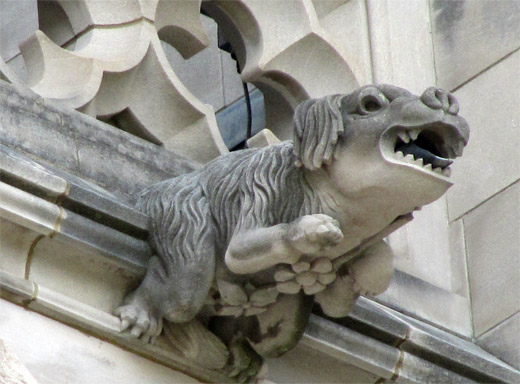 “Excuse me, sir?”
“Excuse me, sir?”
He’s probably ten, but he’s small for his age. His purple ball has rolled into unbusy State Street, and while he’s forbidden to step off the curb, apparently he is allowed to talk to strangers.
“Can you please throw me that ball?”
I do. He’s polite enough not to tell me I’m a strange sight on a Sunday afternoon. Subdued salsa from Puerto Rican cookouts drowns out the car noise. People are chatting; it’s too hot to dance.
“Takin’ pictures, huh?” He holds his ball under one arm and glances at the sky. “You know what would make a good picture? Those gargoyles up there. They’re awesome.”
He’s right. They see everything in Perth Amboy.

Built in 1919 by and for the Polish Catholics of Perth Amboy, St. Stephen’s Church is a fine example of American neo-Gothic, but despite its intricacy, it’s bereft of grotesques—except for the huge faux-gargoyles below the spire.
Weirdly, I can’t find any public information about the architect, but whoever he was, he didn’t Americanize this church, nor did he grant its parishoners (who still run a Polish CCD) a speck of Slavic idiom. No, the mind behind St. Stephen’s adored Western Europe; those gargoyles would be right at home on a cathedral like Bayeux.

Though these gargoyles seem like relics of the city’s better days, prosperity alone doesn’t explain them. In the late 19th and early 20th centuries, when neo-Gothic building was rampant, Perth Amboy was a gargoyle breeding ground. A local abundance of rich clay here and in nearby Woodbridge and New Brunswick meant that Perth Amboy firms like A. Hall and Sons (later the Perth Amboy Terra Cotta Company, later Atlantic Terra Cotta) made grotesques and ornamentation for buildings across the United States, providing decorations for the Woolworth Building, exterior details for the Philadelphia Museum of Art, and the entire roof of the U.S. Supreme Court.
So whose idea were the gargoyles of St. Stephen’s? A 1906 Architectural Record article shows similarly slender beasties made by the Perth Amboy Terra Cotta Company on the first City College of New York building, a neo-Gothic landmark by architect George B. Post.
Then again, Charles Follen McKim of the legendary firm McKim, Mead, and White had attended school in Perth Amboy, and he partnered with the Perth Amboy Terra Cotta Company to make multicolored brick when brownstone and red brick fell out of fashion. It’s tempting to see St. Stephen’s as a “forgotten” work by MM&W or one of the many architects associated with them, but then what if it’s a great Gothic sob by the fanatically medievalist church designer Ralph Adams Cram? Or maybe it’s a monument to the faith of an architect no one has thought to remember.
I asked the folks at St. Stephen’s if they know who built their church; I’ve yet to hear back. Regardless, I’ll bet that like the kid who pointed them out to me, the gargoyles of Perth Amboy were locally born—a hundred years distant, but raised in an age that perceives the medieval wherever you look.









